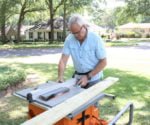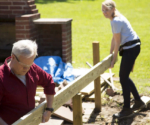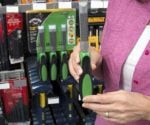Friday, August 31, 2018
Exterior Repairs - Home Improvement – Today's Homeowner
from Home Improvement – Today's Homeowner https://ift.tt/2N8LeaW
How to Fix a Clogged Kitchen Garbage Disposal - Home Improvement – Today's Homeowner
from Home Improvement – Today's Homeowner https://ift.tt/2N6VznC
Flood Fixes - Home Improvement – Today's Homeowner
from Home Improvement – Today's Homeowner https://ift.tt/2MI319l
Monday, August 27, 2018
Installing a Mini Split AC/Heating System in the Shop
This was such a cool week in my shop, and I mean that very literally as I got AC installed.
Temperatures in Texas get hot hot hot during the summer and with as much as I’m in the shop, an AC system is an absolute must. I went ahead and filmed the process of the installation even though I didn’t install the unit myself (I’ll cover why later on). So in this tutorial, I’ll cover why I went with the unit I did and give you an overview of the process so you can kinda know what to expect if you’re looking into doing the same.
I partnered up with two companies for this project so I want to say a big thank you for Carrier Systems and Mini Split King for sponsoring this video.
The first step in the process was to figure out how big of a unit I would need for my space. The factors that play into this are the square footage of the space, how high the ceilings are, R-value of the R-value of my walls, ceiling, windows, and garage doors. When the AC guys ran the numbers they came back and told me I pretty much built a yeti cooler and I would only need a two ton unit to heat and cool the entire space.
And if you recall the video when the spray foam was being added, I mentioned that even though it’s more expensive up front it is so effective that it saves on the heating/cooling step and this is a great example of that in play.

Before Mini Split King showed up, I pulled off the wall sheathing directly underneath where the unit was going to be mounted to the wall. Then ripped the very top sheet in half and remounted only the top half. This is so the unit can be mounted to the wall but the install guys will have access to the bottom of the unit.

Now Carrier has a large range of mini splits able to handle anything from a garage to a house to a shop the size of a house. ; ) I’m going with 2 one ton units that are, by far, the most efficient unit on the market with a SEER rating of 42.

One huge advantage to going with a mini split is it’s a ductless unit, meaning instead of having to run traditional ducting in the attic to distribute the air, it only requires an outside unit called a condenser, then a hole in the wall to connect that to the inside unit called the air handler.
I’ll have one placed on the back wall of each section of my shop so that I can either have both running to heat or cool the entire space, or once I install a bay door in between the two sides of my shop, I can have the option to only heat or cool the side of the shop I’m currently working on. The cooling will be amazing for Texas but it’s worth noting this unit can heat with temps down to -22 outside.
The unit comes with a mounting bracket on the back that can be removed then placed level on the wall. Since this is my woodshop, the guys mounted my unit up pretty high on the wall to keep it away from as much sawdust as possible, although it will still get dust pulled into the filter and need to be cleaned regularly.

Then they punched a hole through my sheathing which will allow the plumbing of the unit to be fed into the wall and down to another hole that will lead to the outside unit. Although the air handler is about ____ x _____ you can see it is pretty light weight.

With the unit securely in place, he next started routing the communication wire which will allow the inside unit to talk to the outside unit.

***A few other features built into this unit is a dehumidification function: Unlike the dry function on regular mini splits this is the only system in the market with a true dehumidifier function built in that will not over cool the space trying to remove humidity. This is great for Wood shops. It has wifi so I can control the unit from my phone annnnd it has a sensor a sensor on the bottom right that you can set to follow you around the shop and direct the vents towards your location.

You can see with the door of the unit open, you can see the filters. With this being in a shop, it’s recommended that I clean the filters out once a week. Cleaning will mean slipping them out (which is simple enough), dunking them in some water, then letting them air dry. Another preventative measure I took since this is a shop is I attached a layer of roll out filter on top of the intake of the unit to catch a lot of the dust before it enters into the internal filters.


Next up was to drill a hole in the bottom of the wall all the way to the outside unit. To keep the outside of the wall from tearing out, Joe started from the inside until the center bit of the holes punched through the outside sheathing. Then he moved to the outside and finished the cut. This hole will be where the interconnecting refrigerant, control and drain lines will be ran through to the condenser.

Once ran these lines can be cut to their proper length and attached, then also tidied up so they fit snugly back into the wall channel.

All in all the inside install took about an hour to an hour in a half. And before you ask, yes it is simple enough to install yourself however there are two key factors on why it’s still a good idea to hire the job out. One is if you buy a unit direct and install it yourself, you won’t get a warranty through the manufacture. If you go through a certified HVAC contractor your unit will have a ten year warranty attached to it, and often the installers will also have some sort of warranty. Mini Spilt Kings offer a two year service warranty when they do a job, so that’s a huge reason to hire the job out. The second reason, I’ll get into in just a second after I show the installation of the outside condenser.
The condenser can be set on the ground on a concrete slab or mounted to the wall. Since I still have some grading to do, I chose to mount mine to the side of my shop, about waist height.

A bracket is placed level on the side of the building where two arms are attached. Then the unit can be set into place and secured down. You can see it’s relatively light weight where one person can lift it.

Next the lines coming out from the inside of the shop can be cut to length and attached to the condenser.

And now comes in point two on why hiring out the install is a good idea. Before adding refrigerate, the system got pressurized with nitrogen to check for leaks and then bled out so that they could connect a vacuum pump that draws out all the air and humidity from the lines.

If this step is skipped then the moisture that is in the lines will always remain in the unit and attach to different parts inside causing corrosion and premature wear and tear on the unit. Once the micron gauge gets to at least 500 microns then the refrigerant can be released throughout the unit, and that means it’s ready to be turned on.
I then went inside the shop and closed the doors and lowered my garage doors. By the way, having these new Wayne Dalton garage doors closed is just as bright as having them open thanks to all the windows. I’m so thrilled with how much natural light they let in.


With the shop closed up I then powered both air handlers up to full blast! And goodness me, are these things quiet!

I turned them on turbo since this is the first time cooling the space, so this is the loudest it will ever be…..which is pretty dang quiet if you ask me. Check out the video above and see.
For finishing details, the guys added in a surge protector so that this $60 protector will need to be replaced instead of the entire unit. I also used some Titebond Weather Master Sealant to caulk around the hole put into the shop then last thing was to replace the inside panels of my shop wall.


I just want to quickly point out, this is exactly why I went the long route of using screws over a nail gun to sheath the inside! It hasn’t even been a year and I’ve removed a few panels here or there to get inside the walls for some reason or another. So I recommend doing the same if you build or have something built.
Ok and that about wraps it up. Having an heat and cooled space is going to be simply amazing. Again, big thank you to Carrier and Mini Split Kings for working with me and sponsoring this project.
Here is a link to the units in case you’d like to check them out https://ift.tt/2LxqMLN
The post Installing a Mini Split AC/Heating System in the Shop appeared first on Wilker Do's.
from Wilker Do's https://ift.tt/2oeGbHV
Fine-Tune Your Woodworking Projects with Just One Tool - Home Improvement – Today's Homeowner
from Home Improvement – Today's Homeowner https://ift.tt/2t58o6I
This Household Product Doubles as a Low-Cost, Non-Toxic Fertilizer - Home Improvement – Today's Homeowner
from Home Improvement – Today's Homeowner https://ift.tt/2liOyRf
Sunday, August 26, 2018
5 Reasons Why Your Air Conditioner is Constantly Running - Home Improvement – Today's Homeowner
from Home Improvement – Today's Homeowner https://ift.tt/2whakuy
5 Improvements That Could Increase Your Home’s Value - Home Improvement – Today's Homeowner
from Home Improvement – Today's Homeowner https://ift.tt/2MUb0PZ
7 Home Renovations That Affect Your Insurance Premiums - Home Improvement – Today's Homeowner
from Home Improvement – Today's Homeowner https://ift.tt/2BMW0PK
Saturday, August 25, 2018
ASK DANNY: Help — Our Bathroom Vent is Blowing Black Dust! - Home Improvement – Today's Homeowner
from Home Improvement – Today's Homeowner https://ift.tt/2BKcUyr
Today’s Homeowner Radio Show for Aug. 18, 2018 - Home Improvement – Today's Homeowner
from Home Improvement – Today's Homeowner https://ift.tt/2PEZc2O
Friday, August 24, 2018
Installing Two Giant Property Gates
Things I Used In This Project:
- ISOTunes Bluetooth Hearing Protection
- Lincoln Power Mig 260
- Welding Hood
- Welding & Grinding Hood
- Welding Jacket
- Welding Gloves
- Welder JD
- Triton Super Jaws
- Cordless Grinder
- Corded Grinder
- Metal Marking Pencil
- Rust-Oleum Primer
- Rust-Oleum Brown Spray Paint
- Lincoln Plasma Cutter
In two previous videos I have shown how I built two different gates for my property. One to the house, and one to the shop. This tutorial/video shows how I got them both installed, which was a pretty big ordeal as they are both large and heavy.
The location of the gate is pushed off the road so that an entire truck and trailer can pull completely into the driveway, off the road, before hitting the gate.

Also, before punching the holes in the ground, I waited until I built the frame for the gates so I could get an exact measurement on how far apart these holes needed to be. They need to be pretty accurate because you only have a few inches of play in both directions. And since I live on solid rock, I had to hire a contractor with a rock auger bit to punch all eight holes.
The holes were about 30 inches deep and there are 4 posts at each gate location. Two for the main posts and two for the sub-posts that will support the main posts that the gate is hinged to. These sub-posts give the main posts much more rigidity.
I started by mixing up concrete and setting up the main posts that the gate will be hinged to, as well as the two sub-posts. All of these posts are left tall at this point and will be cut to their final size after the gate is installed. We made sure all of the posts stayed plumb while they were curing.


For the stringers, I used a smaller diameter pipe. To butt up flush to each other, the ends of these stringers need to be profiled. Cody found this awesome free software online where you can type in the angle and diameter of your pipe and it will spit out a printed template that you can cut out, wrap it around your pipe and trace it to cut. I used my Tomahawk 375 Plasma Cutter to make these cuts.


The main thing to pay attention to here is that you want the profiles to line up to one another. The center of the dip on one end is center with the dip on the other end. We then put the stringers in place to test the fit. And then took off a little bit here and there with a grinder until both sides rested snugly.
I then used a grinder to clean up the posts at the welding point to get a nice weld. And then welded them in place by hooking up a generator to my Lincoln Electric MP210 machine.

The angles of these stringers were chosen because the bottom of these posts is the most secure, being knee deep in concrete. However, the higher up you go, the easier it is to pull the post over. So, you want the stringer placement up high on the post to provide as much support as you can get.
I then put on two coats of primer and two coats of paint.

Moving on to the mounting the gates. We started off with the shop gate. I pulled a straight line down the middle on the hinge side of the gate. And another down the center of the hinges. It’s worth noting that these hinges are rated for 700 lbs. Which is well above what this gate weighs.
We first set a 4’ level on the gate to get it plumb. And then placed the hinge in its spot to get it plumb with a smaller level, using a magnet as a resting shelf.

After getting the hinge where I thought I liked it, I tacked it in place and then welded it shut.

Huge lesson: we found out that the barrel of the hinge wasn’t welded on straight from the manufacturer, which created a big problem of course. So the lesson is to plumb the barrel of the hinge and not the mounting plate. To fix this problem, I cut through the two welds holding the barrel on, just enough to move the barrel over and push it into plumb. I then welded it all into place.

We then used the 4’ level to span from the top hinges down to the bottom hinge to make sure they were on the exact same line. It’s really important to take your time on this step so that the hinges wont get bound up by being misaligned.
Ok, now time to get the gate down to the entrance to weld on the second part of the hinges. Cody wrapped a strap all the way around the gate and lifted it up with the tractor to move it, which worked beautifully. We moved slowly down the driveway so that Brian could keep the gate steady. And then they slowly crept up to the gate to set it in place.

We piled scrap wood on one side and a floor jack on the other to prop up the gate to the height we wanted the gate to be. We then put a level on the gate and then used the jack to raise or lower the gate into level. Once the gate was level, we then scooted the gate into the posts until both of the hinges were resting flat up against the posts.


Now using a magnet, I attached the second part of the hinge. We then used a level to make the gate completely plumb. I tacked the hinges in place. And then we again checked level and plumb before I welded them closed.
And the moment of truth: We were able to let off the tractor and the jack and open it up to see if it worked. And it looked great. We celebrated with a happy dance.

Now that the gate is installed, the second main post can be set. You want to wait until the gate is in so you have a little play over the amount of space between your second main post and the gate. I mixed up a little more concrete and set the second post, leaving about an inch gap. The post came out super nice and plumb, with a super nice and even gap.

Next up was installing the other gate leading to the house. We repeated almost all of the previous steps with just a few differences. One difference was in the stringers that attach the sub-poles to the main poles. This time, we welded them on horizontal instead of at such a steep angle like the ones for the first shop gate. I personally think it looks way cleaner keeping them horizontal.

We plan to add concrete to this driveway in the future, which will require an additional 4 inches of room underneath the gate. So to account for this, we mounted this gate higher (8 inches in the air) than the other gate.
After we got the gate welded on, we once again had that really cool moment where we were able to back off of everything and watch the gate open and close for the very first time. There’s something really cool about building something so huge and then seeing it function and operate.

To finish up I cut all of the posts to their final height. I cut the main posts to be about level with the gate itself. I primed and painted all of the poles and did some touch up paint on the gate where needed. Since I had two bags of concrete left over, I went ahead and filled up both of the main posts that the gates are hinged to. Then to cap off the posts, I ordered some 3 1/2” post caps that are domed on the top that will just slip right over the posts.

The very last thing I did was cut out a small metal flap and welded it to the back of each gate so it will reach out and grab that main post and keep the gate from swinging past it.

I don’t know what it would cost to have these gates built. But I can tell you that we only spent about $1200.00 between both gates. We still need to buy the actuators. But I can still guarantee that is a lot of money saved since I built the gates myself.
The post Installing Two Giant Property Gates appeared first on Wilker Do's.
from Wilker Do's https://ift.tt/2oaCLpw
5 Organizing Tips to Make Your Home More Comfortable - Home Improvement – Today's Homeowner
from Home Improvement – Today's Homeowner https://ift.tt/2Mz71cb
How Covid-19 Affects the Housing Market in College Towns
The Covid-19 pandemic has led to major lifestyle changes. That could significantly impact the housing market in college towns, according to ...
-
Jennifer asks, “How do I go about repairing a scratch in my hardwood floor?” Touch up kits are available for repairing minor damage to wo...
-
WooHoo! The time has come for me to release a very exciting project I’ve been working on for the past couple of months. As my contribution t...










